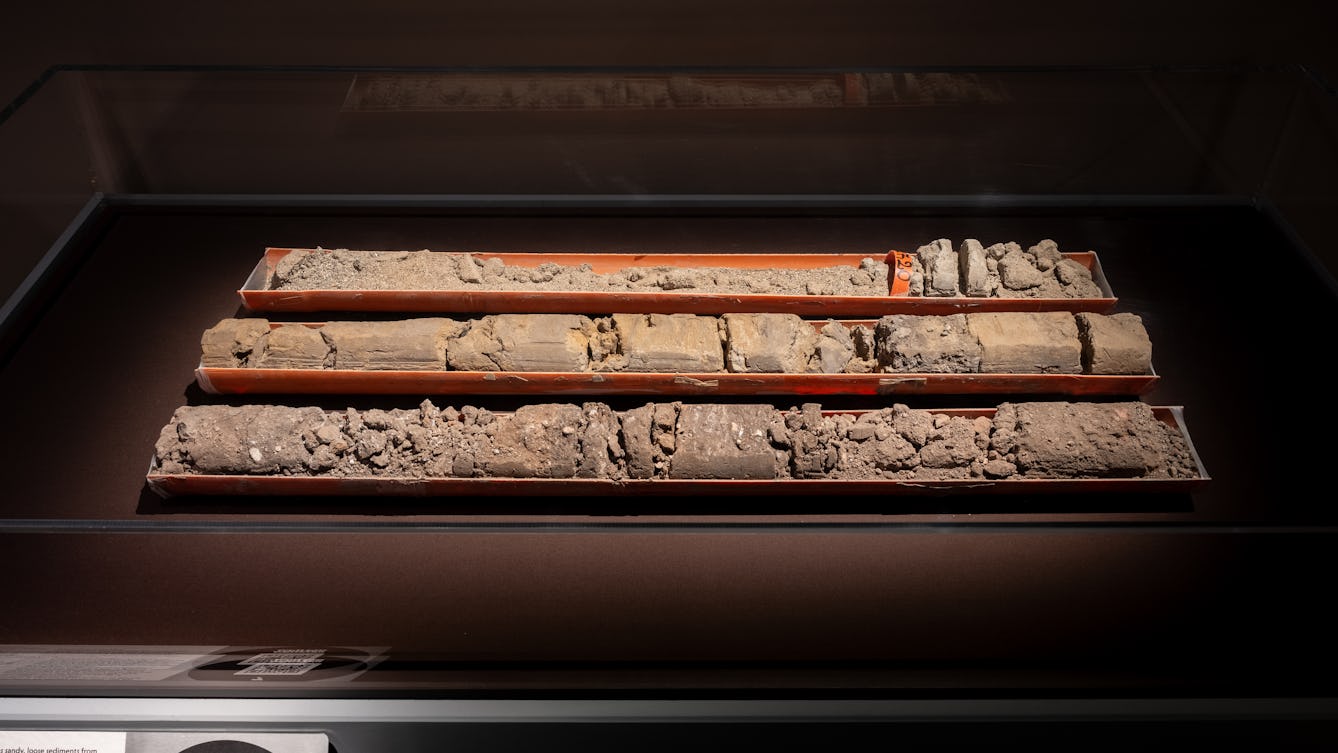Hi, this is Andrea Brock, an environmental archaeologist and lecturer at the University of St Andrews.
Laid out horizontally in the glass case in front of you are three core samples, columns of sediment collected from Rome’s riverbank. These are one-metre sections of much longer cores drilled from the street level to a depth of 15 m – that is how deep you have to go to reach the bottom of the archaeological record in Rome’s central river valley. Myself and my colleagues on the Forum Boarium Project extracted these as part of a geoarchaeological survey of the city’s riverbank district in 2019. These core samples reveal how the Tiber River has changed in the last 4,000 years and new details about how the Eternal City was built in a floodplain.
The top core contains sediments deposited in or very near the Tiber’s active river channel sometime in the second millennium BCE. It is sandy and loose in consistency, peppered with gravel and small, rounded stones – the kind of material you would find on a beach or riverbed.
This sediment was deposited by the Tiber River before the city of Rome existed, when relatively small family groups of prehistoric tribes inhabited central Italy. These cores show how at that time, the Tiber River flowed further east, about 100 m closer to the hills of Rome than it does in the modern day. At this wide point in the river channel, where the waters could spread and slow, prehistoric inhabitants could conduct various activities: bringing animals to drink at the river, fording the river, beaching boats on the sandy shore, among other things.
The middle core represents a major period of transformation in the sixth century BCE, when the area underwent its first major urban development and became exposed to escalating floods. This core sample contains fine-grained sediments, primarily silts, which are characteristic of floodplain landscapes.
When rivers flood over their banks, their water velocity slows and they drop sediment – these repeated flood events created a series of centimetre-thick yellowish layers in the core sample here. In the ancient period, the Tiber River was referred to as flavus, a Latin word which means yellow or golden-coloured, which reflected the yellow tint of the sediment suspended in the water. Layer by layer, the Tiber River deposited this yellowish silt anywhere it flooded. These cores have revealed that Rome’s central riverbank district silted up extremely rapidly – the ground level rose by more than 15 feet in the sixth century alone. This rapid sedimentation and escalating flood levels created novel challenges for local inhabitants.
By the late sixth century BCE, the archaeological record reveals how the Romans had implemented various strategies to manage the effects of floods and sedimentation in their lowland – this included building on raised platforms, constructing embankment walls, dredging, and reclamation projects to fill in low parts of the valley. This period also saw the construction of the Cloaca Maxima, Rome’s first system of sewers and canals, which was a marvel of engineering at the time and parts of which have been maintained and remain operational to this day.
The stratigraphy revealed in the bottom core sample reflects the setting a few centuries later, when the city of Rome had grown considerably and its central riverbank was heavily urbanised. Here we see evidence of intensive human activities in the area: the inclusion of mortar fragments (some look like flecks of chalk) in this sample allow us to date the deposit sometime after the mid-second century BCE, when hydraulic concrete was invented. This transformational technology – a concrete which could set underwater and remain extremely durable even in wet conditions – enabled the Romans to densely urbanise their floodplain and manage watery landscapes across their empire.
In order to build their city on the banks of the Tiber River, the early inhabitants of Rome had to adapt to dynamic conditions: the Tiber River shifted its position, flooded to increasing heights, and brought in considerable volumes of sediment. The ancient Romans responded by employing a multifaceted approach towards flood mitigation and landscape management – activities that required both a large labour force and elite investment in public infrastructure. Complex environmental challenges and the need for collective action early in the city’s history, particularly from the sixth century BCE onwards, shaped Roman society and the development of its republican government.
End of Stop 7.
